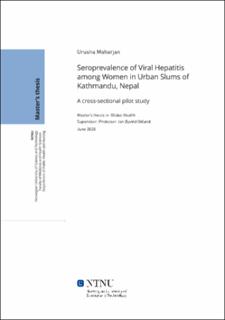| dc.description.abstract | Background: Viral hepatitis is a worldwide public health problem. In Nepal, the prevalence of HAV, HBV and HCV are found to be low but the endemicity of HEV is found to be quite high in Kathmandu since many decades by various studies. But there isn’t any study to explain prevalence of hepatitis infection in the vulnerable population of Nepal. This pilot study assessed the prevalence of viral hepatitis infection among women living in the slum areas of Kathmandu valley, Nepal.
Objective: To determine seroprevalence of viral hepatitis among women in the urban slums of Kathmandu, Nepal.
Methods: A community based cross-sectional study was conducted in three slum areas (Balkhu, Thapathali and Sankhamul) of Kathmandu, Nepal. A semi-structured questionnaire was used to collect socio-demographic and clinical data. Blood specimens of women between age group 18-40 were analysed by rapid diagnostic tests (RDTs) based on immunochromatographic assay for the qualitative detection of hepatitis A, B, C and E virus. The positive samples of HEV were further tested by enzyme linked immunosorbent assay (ELISA) method for the confirmation of virus.
Results: Three hundred and fourteen women were assessed in the study. The seroprevalence of HEV was 1.6%, HBV was 0.3% and none of the women were found positive for HAV and HCV.
Majority of the women were of age group 20-29 (43%) and 76.1% were married. The literacy rate was 76.1% and 35.7% were employed. More than 95% percent of women did not have a history of hepatitis infection and 62.4% have never received the vaccination of hepatitis B. Approximately 37% of women had scarce knowledge about hepatitis infection and 46% knew about jaundice.
Conclusion: In this pilot study, the infection rate of viral hepatitis is very low among women living in the slum areas of Kathmandu. The knowledge about hygiene, sanitation and purification of water among the women might be the reason for low prevalence of hepatitis infection. Further studies on a larger scale is necessary to understand the implications of hepatitis in the slum population.
Keywords: Women, Viral hepatitis, Urban slums, Nepal, Kathmandu | |
